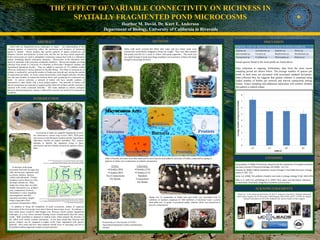More Related Content
Similar to HDAVID2015_POSTER
Similar to HDAVID2015_POSTER (20)
HDAVID2015_POSTER
- 1. THE EFFECT OF VARIABLE CONNECTIVITY ON RICHNESS IN
SPATIALLY FRAGMENTED POND MICROCOSMS
Heather M. David, Dr. Kurt E. Anderson
Department of Biology, University of California in Riverside
ABSTRACT
INTRODUCTION
Food webs are fragmented across landscapes in nature. An understanding of how
changing patterns of connectivity affects the persistence and dynamics of interacting
species is limited. Theory predicts that specific patterns of spatial connectivity can
influence richness and dynamics in food webs, but this has not been tested empirically.
Protist microcosms are used to manipulate connections among food webs in a laboratory
setting, simulating natural community dynamics. Microcosms in the laboratory have
shown to reproduce wild ecosystem community dynamics. Microcosm samples are being
collected from ponds in University of California at Riverside’s Botanical Gardens and
Agricultural Operations Facility. They are added to networks of 175 milliliter bottles
which are connected in various patterns by flexible tubing. The effect of connectivity on
richness is explored by varying the number of bottles per network and varying the number
of connections per bottle. In evenly connected networks, circle shaped networks of bottles
have the same number of connections between them, each containing two connections per
bottle. In uneven networks, a network of bottles will have variable numbers of
connections to other bottles with a more random pattern. The networks of bottles with
uneven connections are expected to support greater food web richness and the converse is
expected with evenly connected networks. This study attempts to inform ecological
theory by demonstrating how richness is affected by network size and level of connectivity
variability.
At the base of the pond
ecosystem food web are algae and
other microscopic organisms such
as protists, diatoms, bacteria,
rotifers and arthropods. Primary
producers such as these are what
the larger animals eat. Many
studies have been done on multi-
trophic interactions (e.g. predator-
prey, competition); however,
information is scarce regarding
microorganisms and their
interaction dynamics, despite
being a large part of the
ecosystem (Amarasekare 2006).
In addition to being the foundation of pond ecosystems, studies of organism
interactions at the microscopic level mirror those at macroscopic levels. An analogy to
these bottle arrays would be land bridges over freeways which connect fragmented
landscapes, or a river whose seasonal flooding creates isolated ponds when the waters
recede. Both contribute to dispersal at random times which sustains the diversity of
life within each mostly isolated community. It has been found that diversity and
species richness can be sustained at higher levels when augmented with species
dispersal. How much and how often dispersal should occur to encourage survival of
the greatest number organisms remains an open question.
The protist Tetrahymena hunts E. coli in this photo illustration, which features a
microscope image of Tetrahymena (left). Credit: University at Buffalo
Read more at: http://phys.org/news/2013-06-dangerous-strains-coli-linger-longer.html#jCp
METHODS DISCUSSION
ACKNOWLEDGEMENTS
“Thank you” to the entities pictured below, Dr. Kurt E. Anderson, Sean Hayes, Ashkaan Fahimipour,
Maria Franco-Aguilar, the UC Riverside CAMP program, HSI-STEM, and UC LEADS, the Student
Veterans Association as well as the Anderson Lab and my Family for their support.
Tubes with mesh covered lids filled with water and two wheat seeds were
secured into wood blocks strapped to bricks for weight. They were then inserted
into ponds and left for a week to collect wild pond organisms. The mesh size
was small enough to keep most larger predators out to preserve richness but large
enough to encourage diversity.
CITATIONSAfter collection, the tubes were then analyzed for novel species and added to networks of bottles connected by piping in
patterns of either even connections or random connections.
EVEN:
•9 bottles (R9)
•5 bottles (R5)
Two Connections
Per Bottle
UNEVEN:
•9 bottles (U9)
•5 bottles (U5)
Random
Connections
Per Bottle
Ecosystems in nature are spatially fragmented yet most
are connected in various ways (Levin 1992). Wild pond
microcosms in the Botanical Gardens and the Agricultural
Operations Facility are largely unstudied. This project
attempts to identify the organisms living in these
microcosms and how habitat connectivity patterns affects
them.
Piping was 14 centimeters in length and each bottle was inoculated with 75
milliliters of medium composed of 1400 milliliters of deionized water, a protist
food pellet and .14 grams of powdered reptile vitamins which was autoclaved to
prevent contamination.
Initial species found in the local ponds are listed above.
Data collection is ongoing. Preliminary data from the most recent
sampling period are shown below. The average number of species per
bottle in each array are presented with associated standard deviations.
Data collected thus far suggests that greater richness is sustained using
higher number of bottles per network and uneven connections among
bottles. Future sampling and additional replication will confirm whether
this pattern is indeed robust.
Picture: How rivers mature and change due to periodic flooding, causing new terrain surface morphologies.
Area: New Orleans showing the changes in Mississippi and Red rivers over ~1000 years.
Credit: © Profantasy's Map‐making Journal | ©2010 ProFantasy Software Ltd. Design by Graham Walmsley
URL: http://rpgmaps.profantasy.com/?p=2017
Pictured above is the location of UCR’s
Agricultural Operations Facility and Botanical
Gardens.
Levin, S.A. (1992). The problem of pattern and scale in ecology. Ecology 73 (6): 1943‐1976.
Amarasekare, P. (2006). Productivity, dispersal and the coexistence of intraguild predators
and prey. Journal of Theoretical Biology 243 (2006): 121‐133.
PARTIAL LIST OF SPECIES IDENTIFIED IN POND SAMPLES
Euglena sp. Scenedesmus sp. Euplotes sp. Volvox sp.
Spirostomum sp. Urostyla sp. Blepharisma sp. Tetrahymena sp.
Paramecium sp. Cyclidium sp. Pleurosigma sp. Halteria sp.
Holyoak, M. (2000). Habitat Subdivision Causes Changes in Food Web Structure. Ecology
Letters 3: 509 ‐ 515.
Polis, G. A., Holt, R.D., and Menge, B. A. (1997). Time, space, and life history: influences
on food webs. Food webs: integration of pattens and processes.
0
1
2
3
4
5
6
7
8
U9 U5 R9 R5
AverageNumberofSpeciesPerBottle
ARRAY
